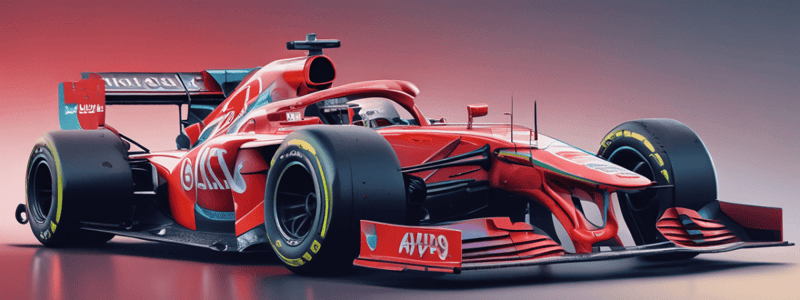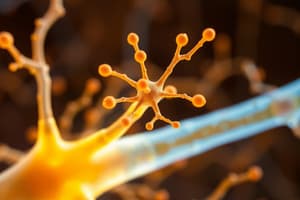Podcast
Questions and Answers
What is the primary function of the front wing?
What is the primary function of the front wing?
- To provide structural support for the car's chassis
- To reduce drag and increase top speed
- To generate lift for better cornering
- To create downforce and manage airflow around the front tires (correct)
What is the purpose of the 500mm-wide neutral section in the central part of the front wing?
What is the purpose of the 500mm-wide neutral section in the central part of the front wing?
- To reduce drag and improve top speed
- To provide additional downforce for better cornering
- To comply with technical regulations for standardization (correct)
- To create a vortex for better airflow around the tires
What is the role of the wing tips in relation to the front wing's performance?
What is the role of the wing tips in relation to the front wing's performance?
- They provide structural support for the wing elements
- They prevent airflow from spilling underneath the wing
- They generate lift to improve straight-line speed
- They create vortices that improve airflow around the car (correct)
What is the purpose of the endplates on the front wing?
What is the purpose of the endplates on the front wing?
What is the function of the footplate attached to the endplates?
What is the function of the footplate attached to the endplates?
What is the significance of the front wing's design in relation to the rest of the car?
What is the significance of the front wing's design in relation to the rest of the car?
What was the primary reason for widening the front wings in 2019?
What was the primary reason for widening the front wings in 2019?
What is the primary purpose of the diffuser in a Formula 1 car?
What is the primary purpose of the diffuser in a Formula 1 car?
What is the purpose of the Drag Reduction System (DRS)?
What is the purpose of the Drag Reduction System (DRS)?
What is the role of the strakes inside the diffuser?
What is the role of the strakes inside the diffuser?
What is the primary function of the suspension in a Formula 1 car?
What is the primary function of the suspension in a Formula 1 car?
What change was made to the rear wing in 2019 to improve the effectiveness of DRS?
What change was made to the rear wing in 2019 to improve the effectiveness of DRS?
What is the primary function of the sidepods on an F1 car?
What is the primary function of the sidepods on an F1 car?
What is the difference between a pushrod and a pullrod suspension?
What is the difference between a pushrod and a pullrod suspension?
How did the positioning of the deformable safety structures change in recent years?
How did the positioning of the deformable safety structures change in recent years?
How do teams optimize the suspension setup for different tracks?
How do teams optimize the suspension setup for different tracks?
What is the purpose of the winglets at the edge of the diffuser?
What is the purpose of the winglets at the edge of the diffuser?
What is the purpose of the undercut design on the bottom of the sidepods?
What is the purpose of the undercut design on the bottom of the sidepods?
How has the design of the diffuser evolved in recent years?
How has the design of the diffuser evolved in recent years?
What is the primary function of the diffuser on an F1 car?
What is the primary function of the diffuser on an F1 car?
How does the diffuser generate downforce?
How does the diffuser generate downforce?
What is the relationship between the suspension and the aerodynamics of a Formula 1 car?
What is the relationship between the suspension and the aerodynamics of a Formula 1 car?
What is the purpose of the flared openings at the rear of the sidepods?
What is the purpose of the flared openings at the rear of the sidepods?
How have the complexity and adjustability of suspension systems in Formula 1 cars evolved over time?
How have the complexity and adjustability of suspension systems in Formula 1 cars evolved over time?
What is the role of the tires in the suspension system of a Formula 1 car?
What is the role of the tires in the suspension system of a Formula 1 car?
Why was the rear wing made taller and wider in 2017?
Why was the rear wing made taller and wider in 2017?
Flashcards are hidden until you start studying
Study Notes
The Front Wing
- The front wing is a critical component of an F1 car, responsible for aerodynamic performance.
- A well-designed front wing improves the car's overall performance, while a poor design can negatively impact the car.
- The central section of the front wing must have a 500mm-wide neutral section.
- The wing's tip elements create a vortex, enhancing airflow around the car and feeding the diffuser.
- The endplates prevent high-pressured air from spilling underneath, increasing downforce and guiding airflow around the tyre.
The Rear Wing
- The drag reduction system (DRS) allows part of the rear wing to open up on a straight, reducing drag and increasing top speed.
- The system lifts the leading edge of the wing by 70mm, creating a larger slot gap.
- The rear wing underwent changes in 2017 and 2019, becoming taller and wider.
- DRS can be activated in specific zones on the track, allowing drivers to attempt overtaking.
- The driver must consider various factors, including braking point and positioning, to successfully overtake.
The Sidepods
- The sidepods package the car's components, housing radiators and manifolds, while minimizing drag.
- The main radiator inlets must accept enough air to provide sufficient cooling to the power unit.
- The deformable safety structures are positioned on either side of the cockpit, playing a crucial role in an F1 car's safety.
- The sidepods feature a distinctive undercut, channelling airflow around the top of the floor.
- The sidepods open up at the rear to expel hot air, and teams often flare these openings at high-temperature circuits.
The Diffuser
- The diffuser is the flared opening at the rear of the floor, responsible for generating the most downforce from the underside of the vehicle.
- Airflow accelerates under the floor, creating a lower pressure area, and thus generating downforce.
- The diffuser must be carefully shaped to ensure no separation of airflow as it exits the space under the car.
- The diffuser area has been revised in recent years, allowing designers to play with the shape and vertical strakes.
- The edge of the diffuser features small winglets, and inside, there are strakes that create vortices to develop the low-pressure zone.
The Suspension
- The suspension is the link between the car and its wheels, dictating how it reacts to the road and driver's inputs.
- F1 cars are allowed up to six structural members per wheel, typically consisting of wishbones, pushrod or pullrod, and a steering arm.
- Teams often employ pullrod suspension at the rear and pushrod at the front.
- The suspension is critical for setting up the car for a specific track, and teams can make changes to camber, toe, spring rates, ride height, and more.
- Tyres act as part of the car's suspension and must be considered when designing the car.
- The suspension also plays a crucial role in the car's aerodynamics.
Studying That Suits You
Use AI to generate personalized quizzes and flashcards to suit your learning preferences.




